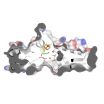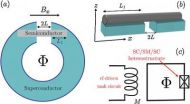(Press-News.org) Scientists at the National Physical Laboratory (NPL) and the University of Leicester have been commissioned by the European Space Agency (ESA) to investigate the feasibility of using dead stars to navigate spacecraft in deep space. The findings of the research will advise ESA strategy and if feasible this technique may in future revolutionise the way spacecraft navigate in the outer Solar System and beyond.
Spacecraft navigation currently relies on radio transmissions between a distant craft and a network of ground-stations on Earth. This means that the craft has to wait for an instruction from Earth to guide it through space and with the large distances involved this could take hours, days or even longer. This time delay affects a spacecraft's ability to react rapidly according to its location. Furthermore, the ground infrastructure is increasingly difficult and expensive to maintain due to the size of the radio antennas.
Scientists at NPL and the University of Leicester are exploring the use of X-rays from dead stars, called pulsars, to allow spacecraft to navigate autonomously. Pulsars are highly compact and rapidly rotating neutron stars that emit intense electromagnetic radiation observed as pulses, similar to the rotating beam of light seen from a light house. In some cases these pulses can be highly regular, making them suitable sources for navigation using a technique similar to GPS.
"Using on-board X-ray detectors, spacecraft could measure the times of pulses received from pulsars to determine the position and motion of the craft. The University of Leicester will use their experience in X-ray astronomy to come-up with potential designs of the device and NPL will develop timing and navigation algorithms to determine the potential accuracy of this technique. Funding received from ESA will allow us to investigate the feasibility of using these dead stars and the potential navigation performance that could be derived." says Setnam Shemar, leading the project on behalf of NPL's Time and Frequency Team.
The traditional form of ground-based space navigation can only support a limited number of spacecraft as only one set of measurements can be processed at any one time. If feasible, this new technique could allow a greater number of complex space missions to take place simultaneously in deep space as craft become capable of navigating themselves.
Results from the investigation will advise ESA on technical strategy and if successful, pulsar navigation could in the long-term reduce costs and limitations associated with ground-based technology. Such a method, using pulsars as nature's own GPS in space, might one day enable humanity to navigate far beyond the outer reaches of our Solar System.
###
The contract is being carried out under the General Studies Programme and funded by the European Space Agency.
Find out more about NPL's Time and Frequency research
Dead stars could be the future of spacecraft navigation
Earth-based systems for tracking spacecraft could be replaced by nature's GPS in space
2012-10-09
ELSE PRESS RELEASES FROM THIS DATE:
IspH -- a protein free to choose its partners
2012-10-09
This press release is available in German.
The iron-sulfur protein IspH plays a central role in the terpene metabolism of several pathogens. The mechanism of the reaction provides an approach for developing new antibiotics, particularly against malaria and tuberculosis. While researching this enzyme, biochemists at the Technische Universitat Munchen discovered a previously unknown reaction: IspH accepts two completely different classes of molecules as partners. This surprising insight, published in Nature Communications, opens up new perspectives in combating infectious ...
Scientists discover gene behind rare disorders
2012-10-09
Scientists at the Montreal Neurological Institute and Hospital – The Neuro, McGill University working with a team at Oxford University have uncovered the genetic defect underlying a group of rare genetic disorders.
Using a new technique that has revolutionized genetic studies, the teams determined that mutations in the RMND1 gene were responsible for severe neurodegenerative disorders, in two infants, ultimately leading to their early death. Although the teams' investigations dealt with an infant, their discovery also has implications for understanding the causes of ...
Chaperone protein subverts removal of glaucoma-causing protein
2012-10-09
Tampa, FL (Oct. 8, 2012) -- The chaperone protein Grp94 can interfere with the clearance of another protein known to cause the glaucoma when mutated, a new study led by researchers at the University of South Florida has found. Using a cell model, the researchers also demonstrated that a new specific inhibitor of Grp94 facilitates clearance of the genetically-defective protein, called myocilin, from cells.
Reported online this month in JBC (The Journal of Biological Chemistry), the discoveries could lead to a new treatment for some hereditary cases of glaucoma, an eye ...
Topological superconductors
2012-10-09
If quantum computers are ever going to perform all those expected feats of code-breaking and number crunching, then their component qubits---tiny ephemeral quantum cells held in a superposition of internal states---will have to be protected from intervention by the outside world. In other words, decoherence, the loss of the qubits' quantum integrity, has to be postponed. Now theoretical physicists at the Joint Quantum Institute (JQI) and the University of Maryland have done an important step forward to understand qubits in a real-world setup. In a new study they show, ...
Bioenergy - The broken promise
2012-10-09
Biofuels are going to save us from climate threats and the oil crisis, while at the same time providing an opportunity to the smallholder farmers of the world. Hopes are high, but completely unrealistic. It is like trying to push a square peg into a round hole, according to a current thesis at Linköping University.
Bioenergy could replace fossil fuels and solve the looming energy crisis. Into the bargain, we will benefit from reduced greenhouse gas emissions. A further bonus could be that demand for biofuels gives a lift to smallholder farmers in poor countries, who would ...
Doubling up on advanced prostate cancer with PARP inhibitors
2012-10-09
A newly discovered function of PARP-1 could be the key to more effective therapeutics to treat advanced prostate cancer patients, a recent preclinical study published in Cancer Discovery by Jefferson's Kimmel Cancer Center researchers suggests.
The team, led by Karen E. Knudsen, Ph.D., Professor in the Departments of Cancer Biology, Urology, & Radiation Oncology at Thomas Jefferson University, found that functions of PARP-1 not only include DNA damage repair but also androgen receptor (AR) regulation in advanced prostate cancer growth and progression. PARP inhibition ...
Chronic kidney disease alters intestinal microbial flora, UCI study finds
2012-10-09
Irvine, Calif., Oct. 9, 2012 – Chronic kidney disease changes the composition of intestinal bacterial microbes that normally play a crucial role in staving off disease-causing pathogens and maintaining micronutrient balance, according to UC Irvine researchers.
This profound alteration of the gut microbial population may contribute to the production of uremic toxins, systemic and local inflammation, and nutritional abnormalities present in patients with advanced renal disease, they said.
Study leader Dr. N.D. Vaziri of the UCI School of Medicine's Division of Nephrology ...
Drawing a line, with carbon nanotubes
2012-10-09
CAMBRIDGE, Mass. -- Carbon nanotubes offer a powerful new way to detect harmful gases in the environment. However, the methods typically used to build carbon nanotube sensors are hazardous and not suited for large-scale production.
A new fabrication method created by MIT chemists — as simple as drawing a line on a sheet of paper — may overcome that obstacle. MIT postdoc Katherine Mirica has designed a new type of pencil lead in which graphite is replaced with a compressed powder of carbon nanotubes. The lead, which can be used with a regular mechanical pencil, can inscribe ...
Academic achievement improved among students active in structured after-school programs
2012-10-09
School-age children who participate in structured after-school activities improve their academic achievement, according to a new study from Southern Methodist University, Dallas.
The study by researchers in SMU's Simmons School of Education and Human Development measured academic performance of students enrolled in Boys and Girls Clubs of Greater Dallas.
"Boys and Girls Clubs of Greater Dallas and other structured programs are really having a positive impact," said Ken Springer, an associate professor. "We believe that the homework support that the clubs consistently ...
How cancer cells break free from tumors
2012-10-09
CAMBRIDGE, MA -- Although tumor metastasis causes about 90 percent of cancer deaths, the exact mechanism that allows cancer cells to spread from one part of the body to another is not well understood. One key question is how tumor cells detach from the structural elements that normally hold tissues in place, then reattach themselves in a new site.
A new study from MIT cancer researchers reveals some of the cellular adhesion molecules that are critical to this process. The findings, published Oct. 9 in Nature Communications, offer potential new cancer drug targets, says ...
LAST 30 PRESS RELEASES:
Why nail-biting, procrastination and other self-sabotaging behaviors are rooted in survival instincts
Regional variations in mechanical properties of porcine leptomeninges
Artificial empathy in therapy and healthcare: advancements in interpersonal interaction technologies
Why some brains switch gears more efficiently than others
UVA’s Jundong Li wins ICDM’S 2025 Tao Li Award for data mining, machine learning
UVA’s low-power, high-performance computer power player Mircea Stan earns National Academy of Inventors fellowship
Not playing by the rules: USU researcher explores filamentous algae dynamics in rivers
Do our body clocks influence our risk of dementia?
Anthropologists offer new evidence of bipedalism in long-debated fossil discovery
Safer receipt paper from wood
Dosage-sensitive genes suggest no whole-genome duplications in ancestral angiosperm
First ancient human herpesvirus genomes document their deep history with humans
Why Some Bacteria Survive Antibiotics and How to Stop Them - New study reveals that bacteria can survive antibiotic treatment through two fundamentally different “shutdown modes”
UCLA study links scar healing to dangerous placenta condition
CHANGE-seq-BE finds off-target changes in the genome from base editors
The Journal of Nuclear Medicine Ahead-of-Print Tip Sheet: January 2, 2026
Delayed or absent first dose of measles, mumps, and rubella vaccination
Trends in US preterm birth rates by household income and race and ethnicity
Study identifies potential biomarker linked to progression and brain inflammation in multiple sclerosis
Many mothers in Norway do not show up for postnatal check-ups
Researchers want to find out why quick clay is so unstable
Superradiant spins show teamwork at the quantum scale
Cleveland Clinic Research links tumor bacteria to immunotherapy resistance in head and neck cancer
First Editorial of 2026: Resisting AI slop
Joint ground- and space-based observations reveal Saturn-mass rogue planet
Inheritable genetic variant offers protection against blood cancer risk and progression
Pigs settled Pacific islands alongside early human voyagers
A Coral reef’s daily pulse reshapes microbes in surrounding waters
EAST Tokamak experiments exceed plasma density limit, offering new approach to fusion ignition
Groundbreaking discovery reveals Africa’s oldest cremation pyre and complex ritual practices
[Press-News.org] Dead stars could be the future of spacecraft navigationEarth-based systems for tracking spacecraft could be replaced by nature's GPS in space


